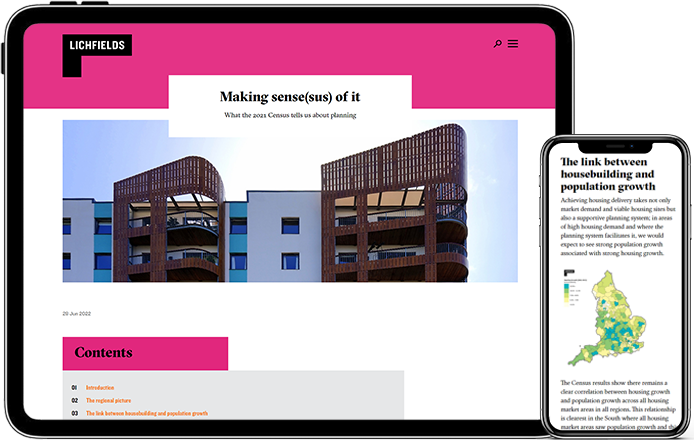Insights
Making sense(sus) of it
What the 2021 Census tells us about planning for housing
Census results released on 28th June show that after a decade of under-delivery of housing, household sizes have increased across the country, and 600,000 potential households have been ‘lost’. In this Insight Focus we take an initial look at the data, and consider how geography, affordability, and housebuilding might offer an understanding of this imbalance and what it means for communities.
In terms of headline growth the Census shows:
- England’s population grew by 6.6% in the ten years to 2021 to 57.2m. This is lower than the 8.0% growth projected in the 2014-based population projections which underpin local plan-making and the standard methodology for calculating local housing need.
- The number of households also grew, by 1.4m to 23.4m – an increase of just 6.2% compared to 2011. This is also lower than growth projected in the 2014-based household projections which expected household growth to be 10.5% over the decade.
With plan-makers using the 2014-based household projections to plan for their communities and calculate local housing need, today’s results start to give us an indication of how communities across the country have changed over the last decade in comparison to their projections.
The 2014-based household projections estimated there would be 24.4m households in 2021, around 1m more than reported today. 400,000 out of this 1,000,000 shortfall in potential households is due to a lower rate of population growth. This had been expected by the ONS (which revised down its subsequent 2016-based and 2018-based projections) owing to a decrease in international migration, life expectancy and birth rates.
This leaves 600,000 households which have been ‘lost’ in the last decade – referred to as suppressed household formation. In the place of creating new households at the rate expected, that would meet a growing population’s needs, household size has increased (by 0.3%) over the same period rather than decreasing by -2.2% as projected. Although the increase might not appear significant, this reverses a near century-long trend of shrinking household sizes, and is at odds with the fact England continues to be an ageing country where there will be an increasing number of single older people, thus implying a reduced propensity to form households of younger adults.



